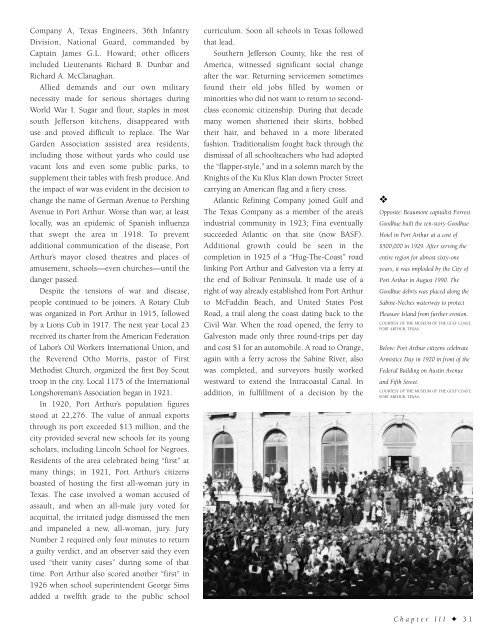Water Rails & Oil - Historic Mid & South Jefferson County
An illustrated history of the Mid and South Jefferson County area, paired with the histories of companies, families and organizations that make the region great.
An illustrated history of the Mid and South Jefferson County area, paired with the histories of companies, families and organizations that make the region great.
Create successful ePaper yourself
Turn your PDF publications into a flip-book with our unique Google optimized e-Paper software.
Company A, Texas Engineers, 36th Infantry<br />
Division, National Guard, commanded by<br />
Captain James G.L. Howard; other officers<br />
included Lieutenants Richard B. Dunbar and<br />
Richard A. McClanaghan.<br />
Allied demands and our own military<br />
necessity made for serious shortages during<br />
World War I. Sugar and flour, staples in most<br />
south <strong>Jefferson</strong> kitchens, disappeared with<br />
use and proved difficult to replace. The War<br />
Garden Association assisted area residents,<br />
including those without yards who could use<br />
vacant lots and even some public parks, to<br />
supplement their tables with fresh produce. And<br />
the impact of war was evident in the decision to<br />
change the name of German Avenue to Pershing<br />
Avenue in Port Arthur. Worse than war, at least<br />
locally, was an epidemic of Spanish influenza<br />
that swept the area in 1918. To prevent<br />
additional communication of the disease, Port<br />
Arthur’s mayor closed theatres and places of<br />
amusement, schools—even churches—until the<br />
danger passed.<br />
Despite the tensions of war and disease,<br />
people continued to be joiners. A Rotary Club<br />
was organized in Port Arthur in 1915, followed<br />
by a Lions Cub in 1917. The next year Local 23<br />
received its charter from the American Federation<br />
of Labor’s <strong>Oil</strong> Workers International Union, and<br />
the Reverend Otho Morris, pastor of First<br />
Methodist Church, organized the first Boy Scout<br />
troop in the city. Local 1175 of the International<br />
Longshoreman’s Association began in 1921.<br />
In 1920, Port Arthur’s population figures<br />
stood at 22,276. The value of annual exports<br />
through its port exceeded $13 million, and the<br />
city provided several new schools for its young<br />
scholars, including Lincoln School for Negroes.<br />
Residents of the area celebrated being “first” at<br />
many things; in 1921, Port Arthur’s citizens<br />
boasted of hosting the first all-woman jury in<br />
Texas. The case involved a woman accused of<br />
assault, and when an all-male jury voted for<br />
acquittal, the irritated judge dismissed the men<br />
and impaneled a new, all-woman, jury. Jury<br />
Number 2 required only four minutes to return<br />
a guilty verdict, and an observer said they even<br />
used “their vanity cases” during some of that<br />
time. Port Arthur also scored another “first” in<br />
1926 when school superintendent George Sims<br />
added a twelfth grade to the public school<br />
curriculum. Soon all schools in Texas followed<br />
that lead.<br />
<strong>South</strong>ern <strong>Jefferson</strong> <strong>County</strong>, like the rest of<br />
America, witnessed significant social change<br />
after the war. Returning servicemen sometimes<br />
found their old jobs filled by women or<br />
minorities who did not want to return to secondclass<br />
economic citizenship. During that decade<br />
many women shortened their skirts, bobbed<br />
their hair, and behaved in a more liberated<br />
fashion. Traditionalism fought back through the<br />
dismissal of all schoolteachers who had adopted<br />
the “flapper-style,” and in a solemn march by the<br />
Knights of the Ku Klux Klan down Procter Street<br />
carrying an American flag and a fiery cross.<br />
Atlantic Refining Company joined Gulf and<br />
The Texas Company as a member of the area’s<br />
industrial community in 1923; Fina eventually<br />
succeeded Atlantic on that site (now BASF).<br />
Additional growth could be seen in the<br />
completion in 1925 of a “Hug-The-Coast” road<br />
linking Port Arthur and Galveston via a ferry at<br />
the end of Bolivar Peninsula. It made use of a<br />
right of way already established from Port Arthur<br />
to McFaddin Beach, and United States Post<br />
Road, a trail along the coast dating back to the<br />
Civil War. When the road opened, the ferry to<br />
Galveston made only three round-trips per day<br />
and cost $1 for an automobile. A road to Orange,<br />
again with a ferry across the Sabine River, also<br />
was completed, and surveyors busily worked<br />
westward to extend the Intracoastal Canal. In<br />
addition, in fulfillment of a decision by the<br />
❖<br />
Opposite: Beaumont capitalist Forrest<br />
Goodhue built the ten-story Goodhue<br />
Hotel in Port Arthur at a cost of<br />
$500,000 in 1929. After serving the<br />
entire region for almost sixty-one<br />
years, it was imploded by the City of<br />
Port Arthur in August 1990. The<br />
Goodhue debris was placed along the<br />
Sabine-Neches waterway to protect<br />
Pleasure Island from further erosion.<br />
COURTESY OF THE MUSEUM OF THE GULF COAST,<br />
PORT ARTHUR, TEXAS.<br />
Below: Port Arthur citizens celebrate<br />
Armistice Day in 1920 in front of the<br />
Federal Building on Austin Avenue<br />
and Fifth Street.<br />
COURTESY OF THE MUSEUM OF THE GULF COAST,<br />
PORT ARTHUR, TEXAS.<br />
Chapter III ✦ 31
















